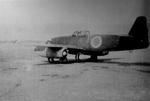J9N-1/J9Y Kikka
| Country | Japan |
| Manufacturer | Nakajima Aircraft Company |
| Primary Role | Jet Fighter |
| Maiden Flight | 7 August 1945 |
Contributor: C. Peter Chen
ww2dbaseThe Kikka prototype jet aircraft were the firsts of the type for Japan. Although the effort to embark on a design for jet fighters was indeed inspired by the German firm Messerschmitt's successes with the Me 262 fighters, the Kikka design was created by Kazuo Ohno and Kenichi Matsumura from the ground up without German assistance, the only exception being the Ishikawajima Ne-20 powerplant which was based on the German BMW 003 axial flow turbojet engine. The prototype conducted its first ground test on 30 Jun 1945, and in Jul 1945 it was disassembled for transport to Kisarazu Naval Airfield. On 7 Aug, it flew for the first time with Lieutenant Commander Susumu Takaoka in the cockpit. On 11 Aug, a second test flight was scheduled, but it came to a sudden end when rocket assisted take off (RATO) equipment caused the aircraft to crash into a drainage ditch. At this point, the second prototype was close to completion, while between 18 and 25 more examples were under construction. The Kikka aircraft were designed to be high speed interceptors, but in the final weeks of the war, Japanese Navy leadership seriously considered to use them as special attack, ie. suicide, weapons despite of their high production cost. As the war ended within days of the takeoff accident, none would see combat action. At least 3 of the under-construction Kikka aircraft were taken by the United States for further studies, and they were likely taken apart to form the partial frame currently on display at the Smithsonian National Air and Space Museum's Steven F. Udvar-Hazy Center in Chantilly, Virginia, United States. Two Ne-20 jet engines were given to the Chrysler Corporation in 1946 for further studies; this fact was not revealed until 2005 (by lead engineer W. I. Chapman).
ww2dbaseSource: Wikipedia
Last Major Revision: Mar 2016
J9N-1/J9Y Kikka Timeline
| 30 Jun 1945 | The first Kikka jet aircraft commended ground tests. |
| 7 Aug 1945 | The Japanese Nakajima J9N-1 Kikka (Orange Blossom) naval special attack jet aircraft made its maiden flight at Kisarazu Naval Airfield in Japan with Lieutenant Commander Susumu Takaoka at the controls. |
| 11 Aug 1945 | The J9N-1 Kikka prototype jet fighter was damaged at Kisarazu Naval Airfield in Japan after a RATO-related take-off accident and the war ended before repairs could be completed. |
| 7 Apr 1947 | Chrysler Corporation, after having studied the Japanese Ne-20 turbojet engine which was originally designed for the Kikka jet aircraft, submitted an official report to the US military. |
SPECIFICATIONS
Kikka
| Machinery | Two Ishikawajima Ne-20 turbojet engines rated at 4.66 kN (475 kgf) each |
| Armament | 2x30mm Type 5 cannon, 1x500kg or 1x800kg bomb |
| Crew | 1 |
| Span | 10.00 m |
| Length | 9.25 m |
| Height | 2.95 m |
| Wing Area | 13.21 m² |
| Weight, Empty | 2,300 kg |
| Weight, Loaded | 3,950 kg |
| Weight, Maximum | 4,088 kg |
| Speed, Maximum | 696 km/h |
| Service Ceiling | 12,303 m |
| Range, Maximum | 1,778 km |
Photographs
 |  |
Please consider supporting us on Patreon. Even $1 per month will go a long way! Thank you. Please help us spread the word: Stay updated with WW2DB: |

- » US State Lawmaker John Winter Caught Using Racial Slur "Jap" and Apologized (11 Jun 2025)
- » Köln/Cologne Evacuated After Discovery of WW2 Bombs (4 Jun 2025)
- » US Women's Army Corps "Six Triple Eight" Awarded with Congressional Gold Medal (30 Apr 2025)
- » Race, Holocaust, and African-American WW2 Histories Removed from the US Naval Academy Library (7 Apr 2025)
- » US Government Plans to Purge WW2 Information (17 Mar 2025)
- » See all news
- » 1,176 biographies
- » 337 events
- » 44,933 timeline entries
- » 1,245 ships
- » 350 aircraft models
- » 207 vehicle models
- » 376 weapon models
- » 123 historical documents
- » 261 facilities
- » 470 book reviews
- » 28,470 photos
- » 365 maps
Lt. Gen. Lewis B. "Chesty" Puller, at Guadalcanal